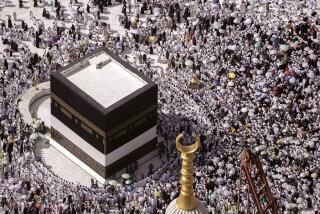Traveling In Style : CORRESPONDENTS’ CHOICE : STREET SCENES
- Share via
AL-SHARIA AL-MUSTAQIM, Damascus
Dodging the bicyclist sweating under sacks of grain, circling a knot of black-gowned women crowding in front of a glittering window filled with 22-carat gold, you pop into a sunlit opening in the covered bazaar of Damascus. Here, more than 2,000 years ago, the Romans laid down a road stretching nearly a mile, from gate to gate in the ancient city wall. They named it Via Recta, or “The Street Called Straight”--Al-Sharia al-Mustaqim in Arabic. According to the New Testament, sight was restored to St. Paul along this road, and except for the crumpled taxis pushing through the throngs, the scene here can’t look much different than it did in his time.
On this end of the street, which locals call Al-Sharia Midhat Pasha, you’ll find old mosques and a caravansary, or travelers’ inn, built by the Ottoman Turks in the 18th Century, and the Buzouriyyeh Souk--the traditional spice market, whose open sacks drench the heavy air with wondrous aromas. East of the spice market, the street is open, a narrow lane of shops, small foundries, furniture makers, jewelers and some of the best treasures of Damascus. This stretch, also called Al-Tariq Bab al-Sharqi (Road of the Eastern Gate), is sublimely quiet compared to the nearby Hamidieh Souk, a tourist alley of inexpensive gimcracks. Even the neighborhood goats trot by without sound.
“I love this place,” says a Parisian photographer, as she crisscrosses from shop to shop along the street like a drunken sailor, spotting old Chinese ceramics (this was a western terminus of the old Silk Road), Muslim inlays and works in copper and brass. “This is where shoppers go to heaven.”
More to Read
Sign up for The Wild
We’ll help you find the best places to hike, bike and run, as well as the perfect silent spots for meditation and yoga.
You may occasionally receive promotional content from the Los Angeles Times.




